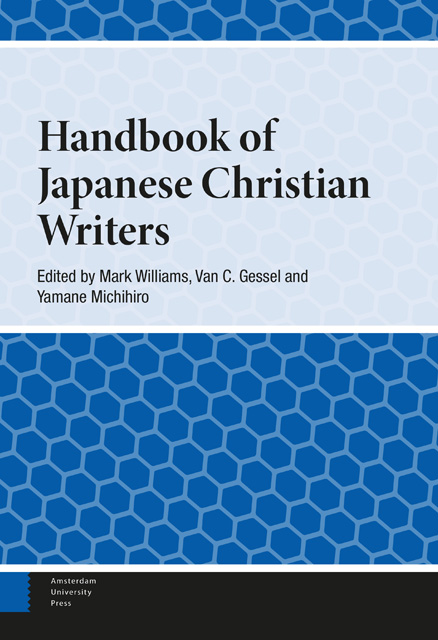Book contents
- Frontmatter
- Contents
- Contributors
- Abbreviations
- Preface
- Introduction
- 1 Prophet of the Inner Life: Kitamura Tōkoku
- 2 Shimazaki Tōson and Christianity: When the Cherries Ripen in the Taishō Period
- 3 Arishima Takeo and Christianity
- 4 Akutagawa Ryūnosuke: A Christian Life
- 5 Incarnation of the Christian Faith in the Poetry of Yagi Jūkichi
- 6 Hori Tatsuo: The Cross Dyed in Bloody Red and the Little Gods of Ancient Times
- 7 Nagai Takashi on Divine Providence and Christian Self-Surrender: Towards a New Understanding of hansai
- 8 Dazai Osamu: His Wrestle with the Bible
- 9 Shiina Rinzō: His Two Visages
- 10 From out of the Depths: Shimao Toshio’s Literary Response to Adversity
- 11 Yasuoka Shōtarō and Christianity: From Postwar “Emptiness” to Religious Longing
- 12 Miura Ayako and the Human Face of Faith
- 13 Endō Shūsaku and the Compassionate Companionship of Christ
- 14 Ogawa Kunio: Renewal of Faith and Identity in His seishomono (Bible Stories)
- 15 Kaga Otohiko: In Search of What Lies Beyond Death
- 16 Sono Ayako: Amor Vincit Omnia
- 17 Takahashi Takako: Drawing Closer to God Through Literature
- Index
- Index of titles
10 - From out of the Depths: Shimao Toshio’s Literary Response to Adversity
Published online by Cambridge University Press: 09 June 2023
- Frontmatter
- Contents
- Contributors
- Abbreviations
- Preface
- Introduction
- 1 Prophet of the Inner Life: Kitamura Tōkoku
- 2 Shimazaki Tōson and Christianity: When the Cherries Ripen in the Taishō Period
- 3 Arishima Takeo and Christianity
- 4 Akutagawa Ryūnosuke: A Christian Life
- 5 Incarnation of the Christian Faith in the Poetry of Yagi Jūkichi
- 6 Hori Tatsuo: The Cross Dyed in Bloody Red and the Little Gods of Ancient Times
- 7 Nagai Takashi on Divine Providence and Christian Self-Surrender: Towards a New Understanding of hansai
- 8 Dazai Osamu: His Wrestle with the Bible
- 9 Shiina Rinzō: His Two Visages
- 10 From out of the Depths: Shimao Toshio’s Literary Response to Adversity
- 11 Yasuoka Shōtarō and Christianity: From Postwar “Emptiness” to Religious Longing
- 12 Miura Ayako and the Human Face of Faith
- 13 Endō Shūsaku and the Compassionate Companionship of Christ
- 14 Ogawa Kunio: Renewal of Faith and Identity in His seishomono (Bible Stories)
- 15 Kaga Otohiko: In Search of What Lies Beyond Death
- 16 Sono Ayako: Amor Vincit Omnia
- 17 Takahashi Takako: Drawing Closer to God Through Literature
- Index
- Index of titles
Summary
As Shimao Toshio prepared to listen to the Shōwa Emperor's famous declaration of surrender at the end of World War II, he and the some 200 men who comprised the tokkōtai (special attack force) under his command on the island of Amami Ōshima had just completed final preparations for the suicide mission for which they had spent the past two years in preparation. Little wonder then that Shimao struggled to come to terms with the ensuing postwar reality. And when this was followed by a decade during which he was obliged to devote most of his attention to care for his wife, whose psychiatric problems he attributed to his own marital infidelity, Shimao found himself turning, by way of “acts of atonement,” both to the Catholic faith and to literary composition. These acts influence Shimao's resulting oeuvre, in particular his epic novel, The Sting of Death.
Introduction
Many authors can cite one specific experience as representing the catalyst for their literary careers. Few, however, can rival the emotional trauma endured by Shimao Toshio (1917– 1986) during the last three days of the Pacific War as the kamikaze squadron he commanded was placed on “ready alert” for their “final mission” on 13 August 1945—only to be spared its appointment with death with the cessation of hostilities some forty-eight hours later. Hardly surprisingly, the young man to emerge from this experience struggled to comprehend the postwar reality with which the entire nation was forced to come to terms, his resulting warped perspective on both life and interpersonal relationships leading to an increased sense of isolation from the real world. The outcome for Shimao was a resort to the world of fiction in an attempt to highlight the disparity he came to see between himself and those around him and, in so doing, to seek to reach a deeper understanding of human nature.
Armed with this experience within that liminal space between life and death, Shimao was quick to recognize the possibilities of literature, and his considerable literary output over the ensuing thirty years is marked by a consistent attempt to place his characters under extreme conditions in the belief that only thus could he truly probe the workings of the human mind.
- Type
- Chapter
- Information
- Handbook of Japanese Christian Writers , pp. 170 - 188Publisher: Amsterdam University PressPrint publication year: 2022



